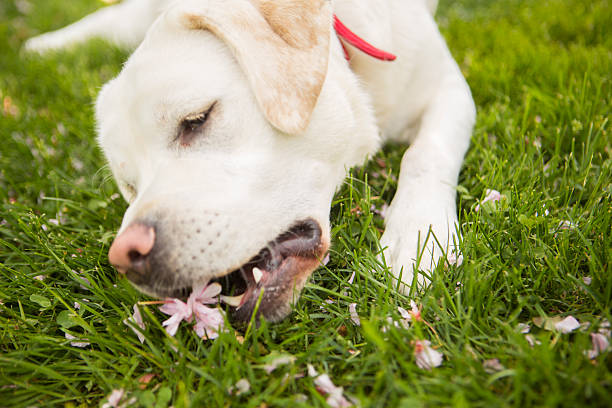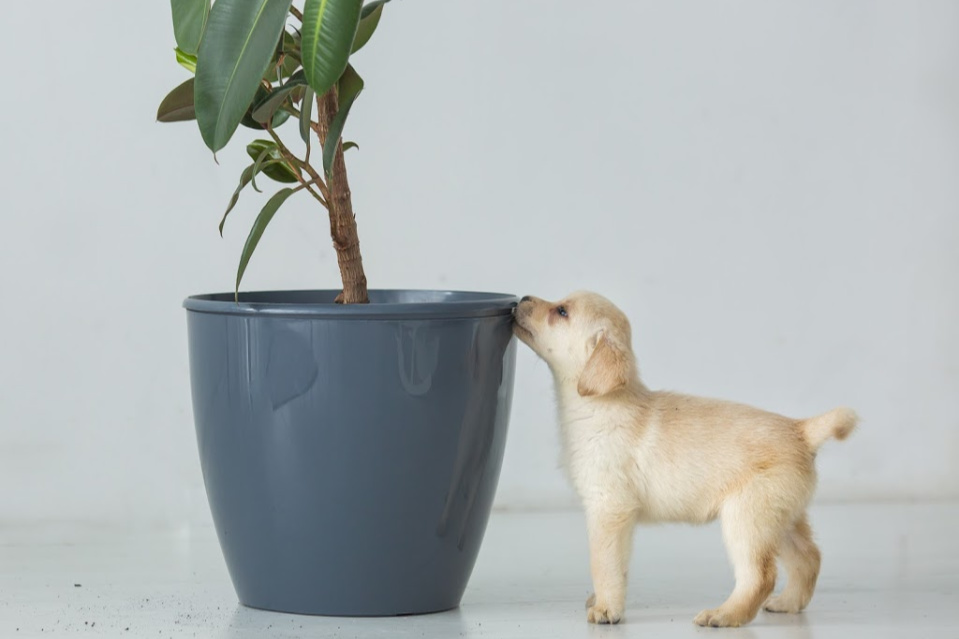Anyone who has ever had a dog will attest to how playful and active these creatures can be, and how much they like putting anything and everything in their mouth, especially when they’re young and teething. Come Spring and they’ll be frolicking about, even more, looking for things to dig up and bury again and generally making a mess in your garden. Chances are, whether during this time or at other times of the year. It is important to know and recognize some of these. Here are 10 plants and flowers that can prove to be lethal for any dog.

Whether because you have an extensive garden or because you have gone out with your dog to someplace with lots of flowers and greenery, and simply because they love experimenting and exploring, your dog may end up chewing and even eating certain plants or flowers. But canine metabolism is not exactly the same as ours, and many plants which may not be that harmful to us can be absolutely lethal for your dog. You have to take care of your dog from any lethal plants and flowers.
Plants and Flowers that could be Lethal for your Dog
Autumn Crocus
The Autumn Crocus, also known as the Meadow Saffron or the Naked Lady. Named so because it resembles real Crocus flowers despite blooming in autumn. It is native to the United Kingdom though it may also found in Portugal, Ukraine, Denmark, Sweden, the Balkans, New Zealand, and the European side of Russia. In temperate climates, it is a common gardening/ornamental flower, which makes it easy for dogs in these countries to come in contact with them. The bulb-like structures of this flower called “corms” contain a drug called colchicine which though used in the treatment of Gout is as deadly and poisonous as arsenic in its unadulterated form, even to humans. To dogs, it is highly dangerous and fatal- it may cause complications ranging from severe mouth irritation and blood vomiting to diarrhea, shock, and organ failure.
Oleander
This highly popular ornamental evergreen shrub, known for its pretty pink or red flowers, is potentially toxic all over and belongs to the very aptly named “dogbane” or Apocynum family of shrubs. From China to Morocco to Portugal to Washington, D.C, and even in parts of the Sahara Desert. It is officially classified as a poisonous plant; its derivatives – oleandrin and oleandrigenin – are classified together as cardiac glycosides, which can have adverse effects on the hearts of both dogs and humans. Although studies have shown that humans are relatively less affected by it (though consuming the seeds in large quantities may still cause death), it can be highly dangerous and lethal for dog. Nausea, tremors, seizures, abnormally fast heart rates, and comas are some of the possible symptoms of Oleander poisoning.
Chinaberry
The chinaberry tree or Melia azedarach, also popularly known by the names white cedar, bead-tree, Cape lilac, syringa berrytree, Persian lilac, and Indian lilac. A form of Mahogany tree found primarily in Australian and Asian countries, particularly along the Indian and Malaysian belts. It can grow up to 40 feet tall, though some known to grow as large as 150 feet. What is of primary concern is their fruits and flowers (though any part of the tree can be dangerous).
Their small flowers are usually purple or lilac in colour and sweet-smelling, while their tiny fruits resemble berries and may be yellow when mature and almost pure white when old. The fruits are harmless to birds but highly toxic to humans and dogs. Consuming them may lead to vomiting, diarrhoea, blood with faeces, cardiac arrest, drooling and weakness in general. The leaves known to be very effective at killing insects but if consumed will have many of the same effects, as will the flowers.
Bella Donna
The Bella Donna or Atropa belladonna, also known as the Deadly Nightshade or the Amaryllis, is a variety of plant found in Europe, Northern Africa, West Asia and parts of the United States and Canada. Known for its distinctive pink flower and small black berries, both of which can be fatally toxic. This plant renowned for its toxicity, with almost all its parts and especially the roots being potentially fatal, even though the plant produces the well-known sedative atropine. Consuming even a single leaf or a handful or berries can kill an adult human being. In animals such as dogs consumption of parts of this plants can cause hallucination, narcosis, faster heart rates and even paralysis. It can also have damaging and long lasting mental effects. Strangely enough, this plant does not seem to harm cows or rabbits.
Foxglove
The Foxglove, also known as the common foxglove, purple foxglove or lady’s glove, is a well-known flowering plant species found commonly in Europe and recognisable by its distinctive bell or trumpet shaped purple flower. Despite their beauty, the flowers of this plant are highly toxic as are their seeds, as they possess Digitoxin- another Cardiac Glycoside. Although derivatives of the toxin sometimes used in the treatment of heart failure. Unsupervised and unadulterated ingestion of the toxin. whether in the form of the flowers and seed. Or in its pure form can cause several potentially fatal complications including low pulse rates, nausea, vomiting and cardiac arrest. Resulting from parts of the heart being contracted due to the toxin. In dogs it may be visible in the form of cardiac arrhythmia and dilated pupils.
Hyacinth
The Hyacinth, immortalized in Greek Mythology. In which it was born out of the blood of the hero Hyacinth, is commonly found. In east Mediterranean regions such as Syria, Lebanon, Israel, Palestine and Turkey, and also in areas of the middle-east, like Iran and Iraq. It is, however, cultivated in gardens all over the world. They belong to the scolidae family of flowering plants which characterized by its bulbs. They distinctly identifiable by their multi-coloured spiked flowers. While the flowers and leaves are toxic by themselves. Their seeds and bulbs are especially lethal for dog due to the presence of oxalic acid. Just handling them may cause irritation of the skin, but consuming them can cause a number of complications. Especially in dogs, including drooling, faster heart rates and breathing difficulties.
Hydrangea
These highly popular flowers, often used in weddings. Change their color depending on the acidity level of the soil the plants grown in. Can found mostly in Asia, especially in China, Japan, and Korea, but can also found in the Americas. Although they resemble rhododendrons, they are actually of a different family entirely. Despite being very popular and beautiful to look at. These flowers are also known for their toxicity, especially to dogs. Consuming them may result in a number of diseases, due to the presence of cyanogenic glycosides or cyanide. Though hydrangeas often smoked as intoxicants like tobacco or marijuana, doing so might eventually result in death. In dogs, they may cause excessive tiredness/lethargy, diarrhea, and vomiting.
Lily of the Valley
Another popular wedding flower (and seen often in royal or celebrity weddings). The Lily of the Valley or Convallaria majalis is a variety of sweet-smelling flowering plant found in woodlands across Asia and Europe as well as in certain parts of the eastern United States. It has been immortalized in Christian legend as being born out of the tears of Eve upon being banished from Paradise. It is highly toxic to both humans and dogs. Also a well-known gardening plant, thus being easily accessible to dogs. Due to the presence of cardiac glycosides, it may cause several heart-based complications. In dogs including cardiac arrhythmia, dropping heart rates and seizures.
Mistletoe
These ever-popular parasitic Christmas plants. Immortal as decorations and as signs of love and luck and also popular as both symbols of death and peace in Norse mythology. May bring good cheer to humans but are highly toxic to dogs. They are originally from Great Britain. But are now found in several forms across Europe, Asia, Northern Africa, Australia and North America. Their distinctive small white berries have been shown to attract more birds. In areas where they grow consequently attracting a greater diversity of animals. Mistletoe trees also provide nests to several different kinds of animals and birds, thus having a positive impact on biodiversity. However, these berries are dangerous for dogs, who may have easy access to it. In woodlands or parks and especially during Christmas. Eating these berries may cause a dog to collapse resulting from hypotension and intense stomach pains.
Rhododendron
Like hydrangeas, the popular evergreen rhododendron shrubs are also toxic, especially to dogs. These flowers have been immortalized across cultures and in literature and have been referenced across history. With one particular legend claiming that eating honey laced with rhododendron toxins caused. The soldiers of Pompey to perish during the Third Mithridatic War during 67 BC. They come in many colors, ranging from red to blue. The presence of a toxin called grayanotoxin in their nectar and pollen makes them dangerous to animals. They are also extremely dangerous to horses. Ingesting one of these flowers may cause vomiting and diarrhea in a dog, alongside blindness, tremors, shaking, and seizures.







